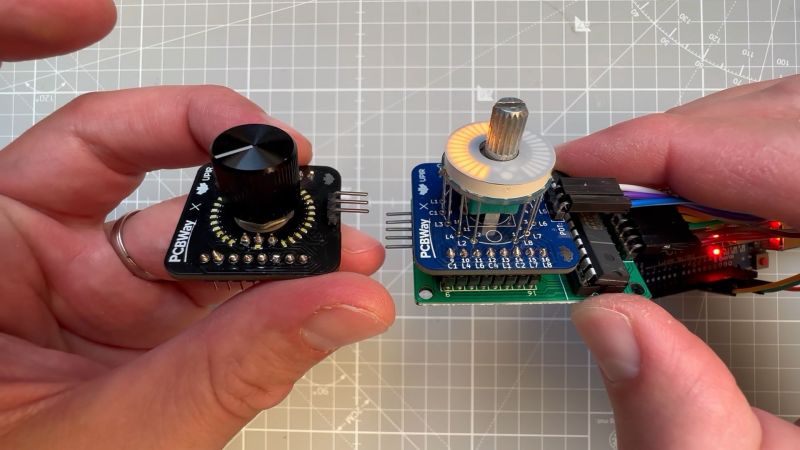If there’s one thing we like around here more than seeing an improved version of a project we’ve already covered, it’s when the improvements make the original project cheaper. In the case of this LED ring light for pots and encoders, not only is it cheaper than its predecessors, it’s better looking and easier to integrate into your projects.
Right from its start, [upir]’s “Pimp My Pot” project has been all about bringing some zazzle to rotary controls. Knobs with a pointer and a scale on the panel are okay — especially when they go to eleven — but more lights mean more fun. The fun comes at a price, though; the previous version of “PMP” used an off-the-shelf LED ring light with a unit cost of about $10. Not the end of the world, perhaps, but prohibitive, and besides, where’s the fun in just buying a component specifically made for rotary control indication?
The new version shown in the video below is pin-compatible with the driver board [upir] used for the previous version, which is based on the MAX7219 display driver. Modifying the previous board to accommodate 32 white 0402 LEDs over a 270° arc was no mean feat. [upir] covers both creating the schematic and the PCB layout in some detail, providing his usual trove of tool-chain tips for minimizing the amount of manual work needed.
Wisely, [upir] chose to get his boards assembled by the vendor; getting all those LEDs to line up perfectly is a job best left to the robots. While the board is designed for use with pots that mount on either side, we much prefer mounting the pot’s shaft through the board, as it keeps the LEDs closer to the knob. The final price per board works out to about $6.30 in quantities of ten and falls to a trivial $1.70 each for lots of 1,000. Pretty sweet savings on a pretty sweet-looking build.
This is a cool use of a ring of LEDs, but if you prefer the finger kind, you can make that, too. You can do it the easy way or the hard way.

















One minor nit to pick, the solder surface tension is technically what lines up the LEDs.
one native KiCad way to create the array is:
– delete all footprints except for LED1
– generate circular array with “assign unique designators”
– back-annotation: Update Schematic From PCB (check “Re-link footprints..”)
addendum: it seems that at least in KiCad 7.0.10, One can place one LED in the schematic update the PCB, generate the circular footprint array and subsequently create the missing schematic symbols, which are linked automatically.
The idea is the same though. KiCad allows for a few liberties when it comes to forward and backward annotations, and this task is one where they turn out to be rather convenient.
I was just today thinking why they don’t add a single small LED inside knobs and some simple slider contact for power to all the devices in the kitchen that have knobs, since it would be low power and relatively simple it would spruce up things and add clarity for at low cost and the low power would make it low risk.
Only problem is that some devices don’t have safe low power, but even when mains referenced it could be done in a way where your fingers/liquid can’t get at it really.
In fact due to the availability of insanely low power LED currently you could even have it be powered with a button cell for ages.
And a button cell could also avoid sliding contacts, all you need is knobs with a LED and a cap with a button cell that goes inside it.
And that brinfs me to suggest someone starts selling knobs for potentiometers that hold a button cell and a small low power led as indicator for us tinkerers.. It would help if it had a switch that turned off the LED at the zero position obv.
Sadly the HaD comment section is one where ideas are never picked up. And yeah there have been other forums where ideas DO get picked up sometimes, in fact sometimes by big companies. But never say never eh.
“I was just today thinking why they don’t add a single small LED inside knobs…”
You can easily put a small LED inside you knob – and I’m sure it has been done. The tears flow when you have to store the battery and resistor in a waterproof case.
Squeeze right for on, squeeze left for off. Unless you’re left-handed, of course.
I just came here to post as Der Pieterzinger.
Thankyou and please tip your waitress.
It’s funny but as I typed ‘knobs’ I was thinking ‘hmm, is this going to elicite certain remarks?’ but then I could not think of another word and thought it would pass by on HaD in a comment on an article on knobs.
Not that I care much mind you.
The US audience might be wondering what we are on about: It’s nothing lads, carry on.
One of the problems with any pointer at the base of a knob (LED’s or a pointer on a panel scale) is the knob which should be as nearly as long as a finger joint obscures this important detail when viewed at any angle but head on. I am a big fan of 10-turn pots and the turns counting dials (number or scale) that go on them.
Perhaps a turn knob with a single digit above it on the panel and if needed for more resolution a ring of 10 LED’s around the digit. 0 to 9.99 there is no 10 yet 11 in one digit. This would be combining the digital and analogue ways of presenting info at once that your fingers don’t cover up. This could match the control of a 10-turn pot.
“..and falls to a trivial $1.70 each for lots of 1,000” – AKA: Coming to an Aliexpress store near you now.
ideal for ‘tempest game arcade’